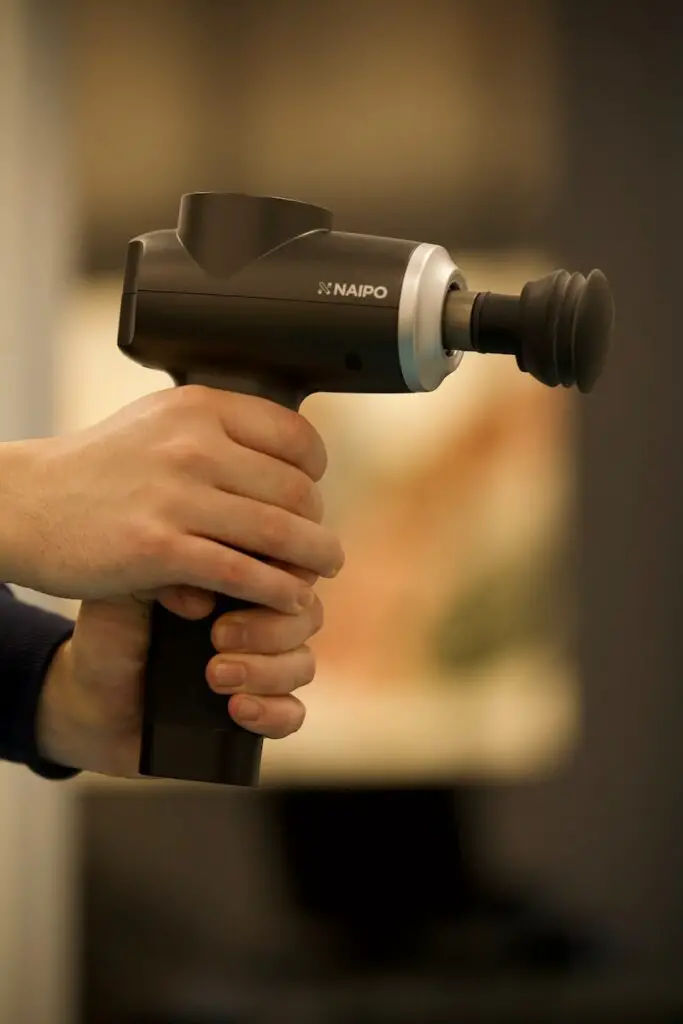
How to Use a Massage Gun After Your Workout: Tips and Techniques
As a triathlete who seems to have a permanent appointment with my physical therapist, I know first-hand the importance of proper post-workout recovery. Back when I was a naive rookie, I thought I could just crush a 50 mile bike ride and 10 mile run every day without consequence. Boy was I wrong. After about a month of that nonsense I was so sore I could barely walk up the stairs to my apartment. It was like Grandpa Joe trying to get out of bed in Willy Wonka! I quickly realized recovery is just as important as the workout itself.

That’s when I discovered the magic of massage guns. These handheld percussive therapy devices are absolute game changers when it comes to muscle recovery. They’re like having your own personal masseuse ready to deliver a deep tissue massage at the push of a button! As a busy entrepreneur and athlete, I don’t always have time for long stretching sessions or ice baths (brrr ❄️) after every workout. But I can always find 5-10 minutes to pummel my muscles with my massage gun.
The pounding action helps to increase blood flow and loosen up tight muscles. It’s not exactly a relaxing spa-like experience – it’s more like getting repeatedly punched by a tiny angry fist. But trust me when I say it’s worth it for how good you feel afterwards! Here’s how to properly use a massage gun after a tough training session:
Understanding Massage Guns
If you’re new to using massage guns, it’s helpful to understand the benefits and how they work before you start pounding away at your muscles.
Benefits
- Reduces muscle soreness
- Improves range of motion
- Speeds up muscle recovery
- Breaks up knots and adhesions
- Increases blood flow to muscles
So in a nutshell, massage guns are like a deep tissue massage and foam rolling combined into one powerful percussive therapy treatment. Just what any athlete or active person needs after a hard workout!
How They Work
Massage guns use a motor to drive attachments up and down against your muscle tissue. They typically come with different attachment heads to target different muscle groups. For example, a round ball head works great on large muscles like the quads and hamstrings. A pointed tip is better for precision work on smaller muscles.
The speed and force delivered by the massage gun helps to loosen up your fascia (connective tissue) and muscle fibers. This increases blood flow and helps reduce soreness and stiffness. It’s kinda like giving your muscles a nice deep tissue massage from the inside out!
Preparing for Use

Before you go hammering away with your massage gun, it’s important to do a few things first:
Choose the Right Attachments
Pick attachments that target the specific muscle groups you want to focus on. For example, if your legs are sore after spin class, opt for a larger round head to really get into your quads and hamstrings.
Start Low and Slow
When first using a massage gun, begin on the lowest setting and with lighter pressure. You can always increase the intensity, but you want to avoid overdoing it, especially on a new muscle group. Building up slowly helps your body adjust.
Avoid Bony Areas
Only use massage guns on areas with plenty of muscle tissue. Avoid bones and joints as the percussive action can do more harm than good.
Ok, now that you’re prepped and ready to rumble, let’s get to the good stuff!
Techniques for Common Muscle Groups
Here are some tips on how to use a massage gun effectively on common problem areas:
Legs
After a killer leg day, your quads and hamstrings likely need some extra love. Using a round attachment head, start at the top of the muscle near your hips. Glide the massage gun down the length of the muscle using long, smooth motions. Adjust the angle to target sore spots and don’t be afraid to use firmer pressure on stubborn knots.
Shoulders
Hunching over a computer all day can do a number on your shoulders. For tight shoulders, use a pointed attachment to really pinpoint those problematic spots. Move the massage gun in a circular motion to help relax the muscles. Focus extra attention on the shoulders and upper back to relieve tension.
Lower Back
Our lower backs seem to always be tight and achy. For this area, try lying on your stomach and using a flat attachment head. Run the massage gun along one side of your lower back at a time, starting at the bottom by your hips and working your way up. Be sure to move slowly and adjust pressure as needed.
You get the idea – target the tight or sore spots and move the massage gun smoothly over the muscle. Now that your muscles are happily loosened up, it’s time to cool down.
Finish Up with Stretches
Massage guns help prepare your muscles for stretching by loosening up tight areas. Follow up your massage gun work by doing some light stretches to improve flexibility:
- Hip flexor stretch
- Hamstring stretch
- Shoulder stretch
Hold each stretch for 30 seconds, breathing deeply. This combo of massage and stretching is the perfect post-workout recovery routine!
While massage guns feel amazing, it’s important to use them safely. Here are a few precautions:
Safety First!
- Never use directly on a recent injury or open wound
- Start at the lowest setting and light pressure
- Don’t use for more than 10 minutes per muscle group
- Stop if you feel any pain or discomfort
Take good care of your muscles and they’ll take good care of you! Now go relax and recover. You earned it champ!



